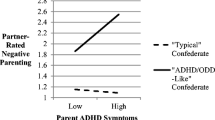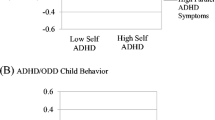Abstract
Reciprocal relationships between child characteristics and such familial factors as parental psychopathology and interaction style with the child characterize the development and maintenance of attention-deficit hyperactivity disorder (ADHD) as well as its comorbidity with antisocial behavior. Our goal was to ascertain the ability of negative maternal behavior exhibited during mothers-on interactions to predict independently observed overt and covert externalizing behavior in the child, controlling for current maternal symptomatology and the boy's acting out behavior during the interaction. Participants were 49 boys with ADHD and 37 comparison boys, aged 6 to 12 years. Hierarchical multiple-regression analyses revealed that, even with maternal psychopathology and child negativity with the mother partialed, maternal negative behaviors predicted both observed noncompliance exhibited in class and play settings and laboratory stealing. Stealing was predicted from maternal negativity even with child interactional compliance controlled. Differential predictions of noncompliance were revealed in ADHD versus comparison families, yet similar patterns emerged for stealing within each group. Results are discussed in light of the high risk for antisocial behavior in ADHD children.
Similar content being viewed by others
References
American Psychiatric Association. (1987).Diagnostic and statistical manual of mental disorders (3rd ed., rev.). Washington, DC: Author.
Anastopoulos, A. D., Guevremont, D. C., Shelton, T. L., & DuPaul, G. J. (1992). Parenting stress among families of children with attention deficit hyperactivity disorder.Journal of Abnormal Child Psychology, 20, 503–520.
Anderson, K. E., Lytton, H., & Romney, D. M. (1986). Mothers' interactions with normal and conduct-disordered boys: Who affects whom?Developmental Psychology, 22, 604–609.
Barkley, R. A. (1985). The family interactions of hyperactive children: Precursors to aggressive behavior? In D. Routh & M. Wolraich (Eds.),Advances in behavioral pediatrics (pp. 117–150). Greenwich, CT;: JAI Press.
Barkley, R. A. (1987).Defiant children: A clinician's manual for parent training. New York: Guilford Press.
Barkley, R. A. (1989). Hyperactive girls and boys: Stimulant drug effects on mother-child interactions.Journal of Child Psychology and Psychiatry, 30, 379–390.
Barkley, R. A. (1990).Attention-deficit hyperactivity disorder: A handbook for diagnosis and treatment. New York: Guilford Press.
Barkley, R. A., & Cunningham, C. E. (1979). The effects of methylphenidate on the mother-child interactions of hyperactive children.Archives of General Psychiatry, 36, 201–208.
Barkley, R. A., Fischer, M., Edelbrock, C. S., & Smallish, L. (1990). The adolescent outcome of hyperactive children diagnosed by research criteria: I. An 8-year prospective follow-up study.Journal of the American Academy of Child and Adolescent Psychiatry, 29, 546–557.
Bell, R. Q., & Harper, L. (1977).Child effects on adults. New York: Wiley.
Biederman, J., Munir, K., & Knee, D. (1987). Conduct and oppositional disorder in clinically referred children with attention deficit disorder: A controlled family study.Journal of the American Academy of Child and Adolescent Psychiatry, 26, 724–727.
Breen, M., & Barkley, R. A. (1988). Parenting stress and child psychopathology in ADHD boys and girls.Journal of Pediatric Psychology, 13, 265–280.
Campbell, S. B. (1990).Behavior problems in preschool children: Clinical and developmental issues. New York: Guilford Press.
Campbell, S. B., March, C. L., Pierce, E. W., Ewing, L. J., & Szumowski, E. K. (1991). Hard-to-manage preschool boys: Family context and the stability of externalizing behavior.Journal of Abnormal Child Psychology, 19, 301–318.
Cicchetti, D. (1990). Perspectives on the interface between normal and atypical development.Development and Psychopathology, 2, 329–333.
Coon, H., Carey, G., Corley, R., & Fulker, D. W. (1992). Identifying children in the Colorado Adoption Project at risk for conduct disorder.Journal of the American Academy of Child and Adolescent Psychiatry, 31, 503–511.
Derogatis, L. (1983).Manual for the Symptom Checklist 90—Revised (SCL-90-R). Baltimore, MD: Author.
Earls, F., & Jung, K. G. (1987). Temperament and home environment characteristics as causal factors in the early development of childhood psychopathology.Journal of the American Academy of Child and Adolescent Psychiatry, 26, 491–498.
Farrington, D. P., Loeber, R., & Van Kammen, W. B. (1990). Long-term criminal outcomes of hyperactivity-impulsivity-attention deficit and conduct problems in childhood. In L. N. Robins & M. Rutter (Eds.),Straight and devious pathways from childhood to adulthood (pp. 62–81). Cambridge, U. K.: Cambridge University Press.
Forehand, R., & McMahon, R. (1981).Helping the noncompliant child: A clinician's guide to parent training. New York: Guilford Press.
Frick, P., Lahey, B. B., Loeber, R., Stouthamer-Loeber, M., Christ, M. A. G., & Hanson, K. (1992). Familial risk factors to oppositional defiant disorder and conduct disorder: Parental psychopathology and maternal parenting.Journal of Consulting and Clinical Psychology, 60, 49–55.
Goodman, R., & Stevenson, J. (1989). A twin study of hyperactivity: II. The aetiological role of genes, family relationships, and perinatal adversity.Journal of Child Psychology and Psychiatry, 30, 691–709.
Goyette, C. H., Conners, C. K., & Ulrich, R. F. (1978). Normative data on Revised Conners Parent and Teacher Rating Scales.Journal of Abnormal Child Psychology, 6, 221–236.
Herjanic, B. (1981).The Diagnostic Interview for Children and Adolescents: Parent version (DICA-P). St. Louis: Washington University.
Hinshaw, S. P., Heller, T., & McHale, J. P. (1992). Covert antisocial behavior in boys with attention-deficit hyperactivity disorder: External validation and effects of methylphenidate.Journal of Consulting and Clinical Psychology, 60, 274–281.
Hinshaw, S. P., Heller, T., & Simmel, C. (1992, February).Covert antisocial behavior in boys with ADHD: Effects of stimulant medication and moral reasoning. Paper presented at the annual meeting of the Society for Research in Child and Adolescent Psychopathology, Sarasota.
Hinshaw, S. P., Henker, B., Whalen, C. K., Erhardt, D., & Dunnington, R. E. (1989). Aggressive, prosocial, and nonsocial behavior in hyperactive boys: Dose effects of methylphenidate in naturalistic settings.Journal of Consulting and Clinical Psychology, 57, 636–643.
Hollingshead, A. B. (1975).Four-factor index of social position. New Haven, CT: Yale University Department of Sociology.
Humphries, T., Kinsbourne, M., & Swanson, J. (1978). Stimulant effects on cooperation and social interaction between hyperactive children and their mothers.Journal of Child Psychology and Psychiatry, 19, 13–22.
Jacobvitz, D., & Sroufe, L. A. (1987). The early caregiver-child relationship and attention deficit disorder with hyperactivity in kindergarten: A prospective study.Child Development, 58, 1488–1495.
Johnston, C., & Pelham, W. E. (1990). Maternal characteristics, ratings of child behavior, and mother-child interactions in families of children with externalizing disorders.Journal of Abnormal Child Psychology, 18, 407–417.
Kazdin, A. E. (1992). Overt and covert antisocial behavior: Child and family characteristics among psychiatric inpatient children.Journal of Child and Family Studies, 1, 3–20.
Klein, R. G., & Mannuzza, S. (1991). Long-term outcome of hyperactive children: A review.Journal of the American Academy of Child and Adolescent Psychiatry, 30, 383–387.
Lilienfeld, S. O., & Waldman, I. D. (1990). The relation between childhood attention-deficit hyperactivity disorder and adult antisocial behavior reexamined: The problem of heterogeneity.Clinical Psychology Review, 10, 699–725.
Lochman, J. E., Dodge, K. A., & Craven, S. V. (1993, February).Predictive effects of boys' aggression and family conflict on boys' psychopathology at two age levels. Poster presented at the annual meeting of the Society for Research on Child and Adolescent Psychopathology, Santa Fe.
Loeber, R., & Schmaling, K. B. (1985). Empirical evidence for overt and covert patterns of antisocial conduct problems: A meta-analysis.Journal of Abnormal Child Psychology, 13, 337–352.
Loney, J. (1987). Hyperactivity and aggression in the diagnosis of attention deficit disorder. In B. B. Lahey & A. E. Kazdin (Eds.),Advances in clinical child psychology (Vol. 10, pp. 99–135). New York: Plenum Press.
Loney, J., Kramer, J., & Milich, R. S. (1981). The hyperactive child grows up: Predictors of symptoms, delinquency, and achievement at follow-up. In K. D. Gadow & J. Loney (Eds.),Psychosocial aspects of drug treatment for hyperactivity (pp. 381–415). Boulder, CO: Westview Press.
Mannuzza, S., Klein, R. G., Konig, P. H., & Giampino, T. L. (1990). Childhood predictors of psychiatric status in the young adulthood of hyperactive boys: A study controlling for chance associations. In L. N. Robins & M. Rutter (Eds.),Straight and devious pathways from childhood to adulthood (pp. 279–299). New York: Cambridge University Press.
Mash, E. J., & Johnston, C. (1990). Determinants of parenting stress: Illustrations from families of hyperactive children and families of physically abused children.Journal of Clinical Child Psychology, 19, 313–338.
Moffitt, T. E. (1990). Juvenile delinquency and attention deficit disorder: Boys' developmental trajectories from age 3 to age 15.Child Development, 61, 893–910.
Olweus, D. (1980). Familial and temperamental determinants of aggressive behavior in adolescent boys: A causal analysis.Developmental Psychology, 16, 644–660.
Paternite, C. E., & Loney, J. (1980). Childhood hyperkinesis: Relationships between symptomatology and home environment. In C. K. Whalen & B. Henker (Eds.),Hyperactive children: The social ecology of identification and treatment (pp. 104–141). New York: Academic Press.
Patterson, G. R. (1982).Coercive family process. Eugene, OR: Castalia.
Patterson, G. R. (1986). Performance models for antisocial boys.American Psychologist, 41, 432–444.
Patterson, G. R., & Stouthamer-Loeber, M. (1984). The correlation of family management practices and delinquency.Child Development, 55, 1299–1307.
Pedhazur, E. J. (1982).Multiple regression in behavioral research. New York: Holt, Rinehart & Winston.
Pelham, W. E., Gnagy, E. M., Greenslade, L., & Millich, R. (1992). Teacher ratings of DSM-III-R symptoms for the disruptive behavior disorders.Journal of the American Academy of Child and Adolescent Psychiatry, 31, 210–218.
Richters, J. (1992). Depressed mothers as informants about their children: A critical review of the evidence for distortion.Psychological Bulletin, 112, 485–499.
Schachar, R., & Wachsmuth, R. (1990). Hyperactivity and parental psychopathology.Journal of Child Psychology and Psychiatry, 31, 381–392.
Tallmadge, J., & Barkley, R. A. (1983). The interactions of hyperactive and normal boys with their fathers and mothers.Journal of Abnormal Child Psychology, 11, 565–580.
Wechsler, D. (1974).The Wechsler Intelligence Scale for Children—Revised. New York: The Psychological Corporation.
Wender, P. (1985). The Adult Questionnaire—Childhood Characteristics.Psychopharmacology Bulletin, 20, 427–428.
Author information
Authors and Affiliations
Additional information
This article is based, in part, on a doctoral dissertation written by Carolyn A. Anderson at the University of California, Los Angeles. The research received primary support from National Institute of Mental Health Grant 45064, awarded to Stephen P. Hinshaw. Partial support was received from the Fernald Child Study Center of the University of California, Los Angeles, where the 1990 summer research program was housed, and from a Faculty Research Grant to Stephen P. Hinshaw from the University of California, Berkeley. We express our deep appreciation to the many behavior observers and research staff, too numerous to mention individually, who were essential in collecting and coding the primary data for the study, and to the children and families who participated in the family assessments and summer research programs.
Rights and permissions
About this article
Cite this article
Anderson, C.A., Hinshaw, S.P. & Simmel, C. Mother-child interactions in ADHD and comparison boys: Relationships with overt and covert externalizing behavior. J Abnorm Child Psychol 22, 247–265 (1994). https://doi.org/10.1007/BF02167903
Revised:
Issue Date:
DOI: https://doi.org/10.1007/BF02167903




